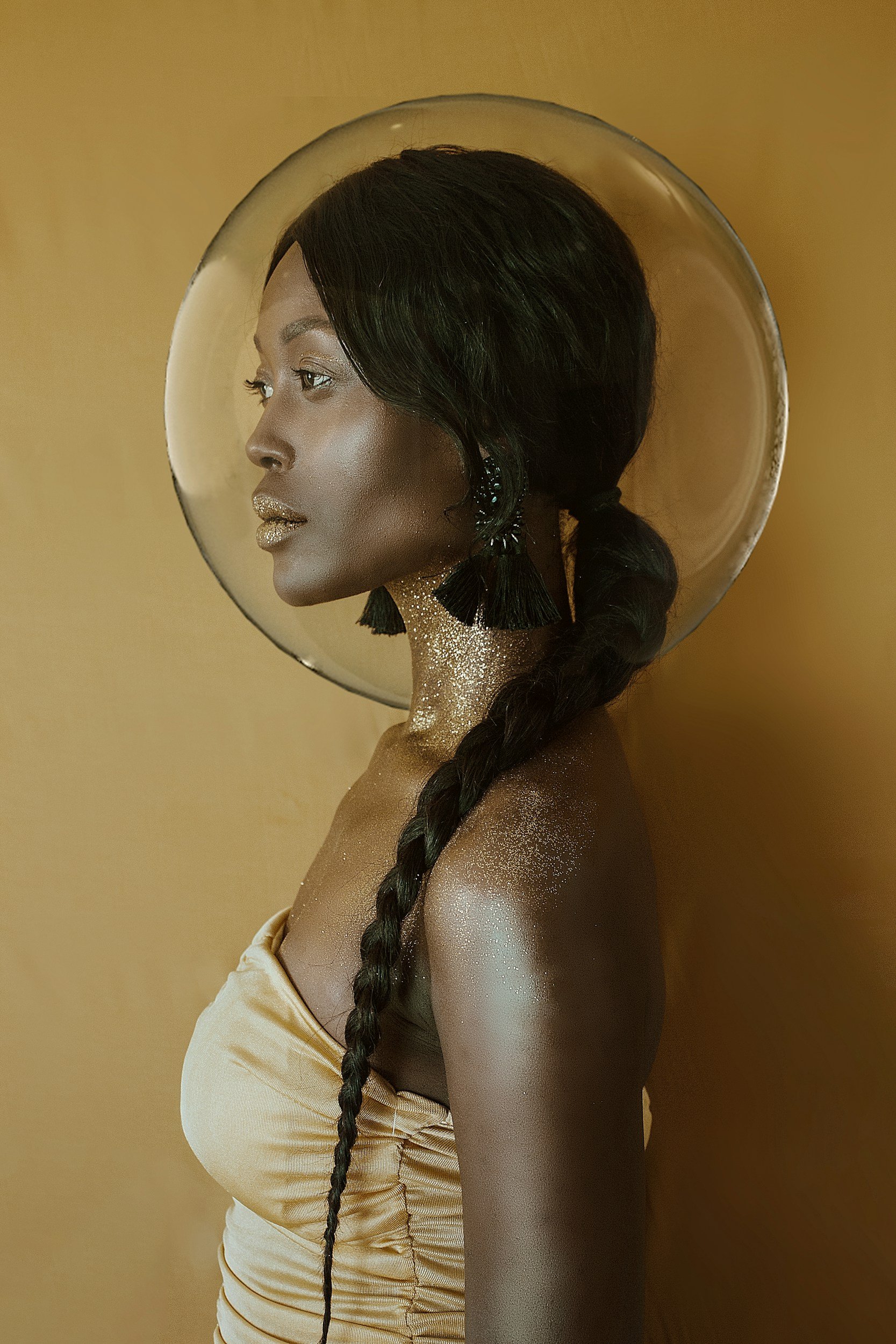Designing for the Future: How BIPOC Designers Are Shaping Tomorrow
For decades, the design industry has been dominated by a narrow narrative, one that often overlooks the talent, vision, and cultural depth of BIPOC creatives. That narrative is being rewritten. Across industries, underrepresented designers are reshaping the visual language of our world, bringing authenticity, identity, and community to the forefront.
In Episode Seven of The Four Percent Amplified, Sunni is joined by Eseosa Eke, Creative Director and Founder of Iconiq Creative, a multidisciplinary studio that builds human-centered, culture-driven brands. Esosa’s work challenges what design can be, expanding it beyond aesthetics into a tool for storytelling, cultural preservation, and social change.
Her creative philosophy? Design isn’t just about making things look good; it’s about making them feel real. Whether it’s the colors chosen, the typography used, or the stories told, every choice has meaning, and every detail is rooted in community.
Breaking Barriers in the Industry
Eseosa is redefining what leadership and success look like in the design world by pushing back against the dominance of Eurocentric, corporate-minimalist aesthetics. Instead of chasing trends that strip brands of personality, she builds identities rooted in culture, history, and human connection. Her work amplifies voices and perspectives that have been historically sidelined, proving that authenticity and representation aren’t just creative choices, they’re strategic advantages. By centering real stories and lived experiences, she’s carving out space for BIPOC designers to lead the industry forward on their own terms.
Special Guest:
Eseosa Eke, Creative Director & Founder of Iconiq Creative
Eseosa is the Creative Director and visionary founder behind Iconiq Creative Group, a bold studio dedicated to building unapologetic, culture-driven brands for social impact leaders. Under her leadership, Iconiq transforms followable brand concepts into magnetic experiences rooted in mission and identity. From "Voice‑Driven Strategy" to raw, authentic visual storytelling, Esosa’s approach reframes branding as a powerful tool for connection, not just design for decoration.
At the core of her work is a belief in confident leadership: “Designing beyond logos, brand strategy now starts with leadership.” Esosa champions authenticity, helping organizations elevate their narratives from speaking at communities to engaging in genuine conversation.
Her client roster spans organizations like the Black Freedom Collective, Advancing Women in Investing, CAS, and others focused on cultural and social change. Past collaborators highlight Esosa and her team’s warmth, professionalism, and ability to bring heart-centered vision to life.
Key Highlights of ESosa’s Work:
Mission-Aligned Client Work – Partnered with groups like the Black Freedom Collective, Advancing Women in Investing, CAS, and Marijuana Justice.
Identity-First Approach – Designs beyond aesthetics, using strategy and storytelling to reflect community voice and cultural authenticity.
Multidisciplinary Studio Leadership – Oversees projects from brand naming and messaging to full visual identity systems and campaign collateral.
Cultural Influence – Advocates for authenticity, representation, and narrative-rich visuals that challenge industry norms.
Thought Leader – Speaks on topics like design as cultural storytelling, brand strategy, and breaking free from the corporate minimalist mold.
You can connect with Esosa on LinkedIn.
Takeaways from Eseosa
Authenticity is Non-Negotiable – True connection happens when brands are built around real stories, identities, and lived experiences.
Design is Culture-Building – Visual identity is more than aesthetics—it can preserve heritage, amplify community voices, and challenge dominant narratives.
Representation is Power – Inclusive design isn’t a trend; it’s a necessary shift that shapes the future of creative industries.
Breaking the Mold – Moving away from corporate-minimalist norms toward vibrant, identity-driven branding creates deeper resonance.
Lead with Intention – Purposeful design choices signal values, invite trust, and attract the right audience.
Storytelling as Strategy – A well-crafted narrative makes a brand relatable, memorable, and emotionally impactful.
Navigating the Industry as a Creative of Color – How to stand firm in your vision despite gatekeeping and systemic barriers.
Building a Multidisciplinary Studio – The realities, challenges, and rewards of managing diverse creative projects under one roof.
Community at the Core – Centering the people you serve leads to brands that are both sustainable and meaningful.
Future Vision – Why the next era of design will be shaped by those willing to break rules, challenge norms, and embrace cultural richness.
Representation as a Design Principle
Representation isn’t just about including diverse faces in a campaign; it’s about embedding cultural authenticity into the DNA of a brand. For Eseosa, this means honoring the histories, identities, and voices of the communities a brand serves, rather than diluting them for mass appeal. It’s about asking the deeper questions: Who are we designing for? Whose story are we telling? And how can we ensure that the story is told with accuracy, dignity, and pride?
When representation is treated as a design principle, it becomes a guiding force in every creative decision, from brand strategy and messaging to the choice of color palettes, typography, photography, and tone of voice. It’s not a layer added at the end; it’s woven in from the very beginning.
Eseosa’s approach challenges the industry’s habit of creating work that’s “universally appealing” by stripping away specificity. Instead, she believes in leaning into the details that make a community unique, its traditions, languages, textures, symbols, and lived realities, because those details are what foster true emotional connection.
When people can see themselves, hear themselves, and feel seen in a brand’s presence, it does more than create customer loyalty, it builds trust, nurtures belonging, and helps shift the cultural narrative. And that kind of representation has the power to inspire, empower, and create ripple effects far beyond the design industry.
Beyond Aesthetics
Design is often reduced to surface-level beauty, colors, fonts, and layouts, but for Eseosa, it’s so much more than that. Going beyond aesthetics means looking past what’s visually pleasing and asking what a design communicates, how it makes people feel, and whether it carries meaning for the community it’s meant to serve. It’s about designing with purpose, where every choice, down to the smallest detail, reflects a brand’s values, story, and audience.
Eseosa approaches design as a conversation between the creator and the community. It’s not just “Does this look good?” but “Does this feel right? Does it speak to the people it’s for? Does it reflect their truth?” A polished, trendy brand that lacks cultural depth or emotional connection might grab attention for a moment, but it won’t sustain trust or loyalty over time.
Instead, she leans into identity, heritage, and storytelling, crafting visuals that are not only beautiful but also rooted in something real. By weaving narrative and strategy into the creative process, she ensures that her designs are as functional and impactful as they are visually striking.
Beyond aesthetics also means being intentional about the spaces design occupies and the emotions it evokes. It’s about creating experiences, not just visuals, brands that live in people’s memories because they’ve touched them in a meaningful way. For Eseosa, beauty is just the starting point; the true goal is resonance.
Final Thoughts
Episode 7 is a reminder that the future of design will be built by those willing to lead with authenticity, cultural depth, and intentionality. Eseosa’s approach shows that when you go beyond aesthetics and treat representation as a core design principle, you create work that doesn’t just look good; it means something.
Her vision challenges the industry to step away from generic, one-size-fits-all branding and toward work that tells real stories, honors identity, and fosters emotional connection. It’s proof that design can be both beautiful and transformative, serving as a bridge between communities and the brands that represent them.
For underrepresented creatives, this conversation is more than inspiration; it’s a blueprint. A call to build without compromise, to center culture in the creative process, and to trust that the most powerful design is the kind that resonates, reflects, and redefines.
What did you think of this episode? What’s one action you’re ready to take to better advocate for your worth as a creative? And what topics or guests would you love to hear from next? Share your thoughts with us on Instagram @thefourpercentamped or drop a comment below we’d love to keep the conversation going!








